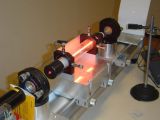There are probably more myths circling around about Lasers, than about any other invention of the 20th century. However a very small number of people actually know what a Laser is or how it works, though they are currently being used in many domains such as medicine, physics and technology applications.
A Laser device produces a coherent emission of radiation, in a narrow beam of bright light that presents a very low divergence, meaning the light beams are mostly parallel, in a well defined area of the wavelength of the light spectrum, unlike the typical light bulb which spreads light all around it and over a wide area of the light spectrum.
The first prediction of the invention of the Laser was made in 1917 by Albert Einstein, which provided the theoretical background needed to build the predecessor of the Laser, the maser device that emitted amplified microwave radiation instead of visible light. The first working Laser emitting visible light was tested in 1960 by Theodore H. Maiman by using a synthetic ruby crystal active medium, which was able to operate only in pulsing modes and gave off a laser beam at 694 nanometers equivalent to the red color of light.
The word LASER, is actually a acronym for Light Amplification by Stimulated Emission of Radiation. A basic Laser device consists of an active laser medium, a Laser pumping energy that provides the energy needed to power the Laser, two high reflecting mirrors and an output coupler that controls the light output of the laser.
The Laser device works by pumping energy into the active laser medium, thus exciting the atoms of the material. The energy stored inside the active medium of the Laser during the excitation process cannot remain inside the atoms for an infinite amount of time, thus they release it by emitting energy in the form of photon particles, or light. While some photon particles are emitted in random directions, some would have perpendicular trajectories to the two parallel mirrors, with high reflective properties, one with 100 percent reflectiveness and the other 99 percent.
Photons trapped between the two mirrors travel back and forth through the active medium, further exciting the atoms and determining them in the process to emit ever more photon particles. As light goes back and forth through the active medium it also gathers energy until it has enough to tunnel through the 99 percent reflective mirror and produce a Laser light beam.
The active medium of the laser can consist of several materials, either in gas states, such as helium-neon or carbon dioxide, or in solid state, like ruby crystals of semiconductor materials. However while the gas state lasers are rather bulky, semiconductor lasers have the advantage of being small, and have now a widely spread use worldwide, more than one billion being produced around the globe every year, to be used in optical data storing devices.
The first practical use for the Laser technology was implemented in 1974, in the well known barcode scanners used in supermarkets, and four years later the first laserdisc player was introduced on the market, thus becoming the first device ever that contained a Laser, which became common in the homes of the consumers.
Popular myths and misunderstanding, involve visible Laser beams in voids, or visible light beams being used in security system alarms. The truth is that Laser beams are invisible in space, as there is no material on which light scattering to take place and it is actually cheaper and more efficient to use infrared invisible Lasers in security systems, rather than visible beams of light.

 14 DAY TRIAL //
14 DAY TRIAL // 
